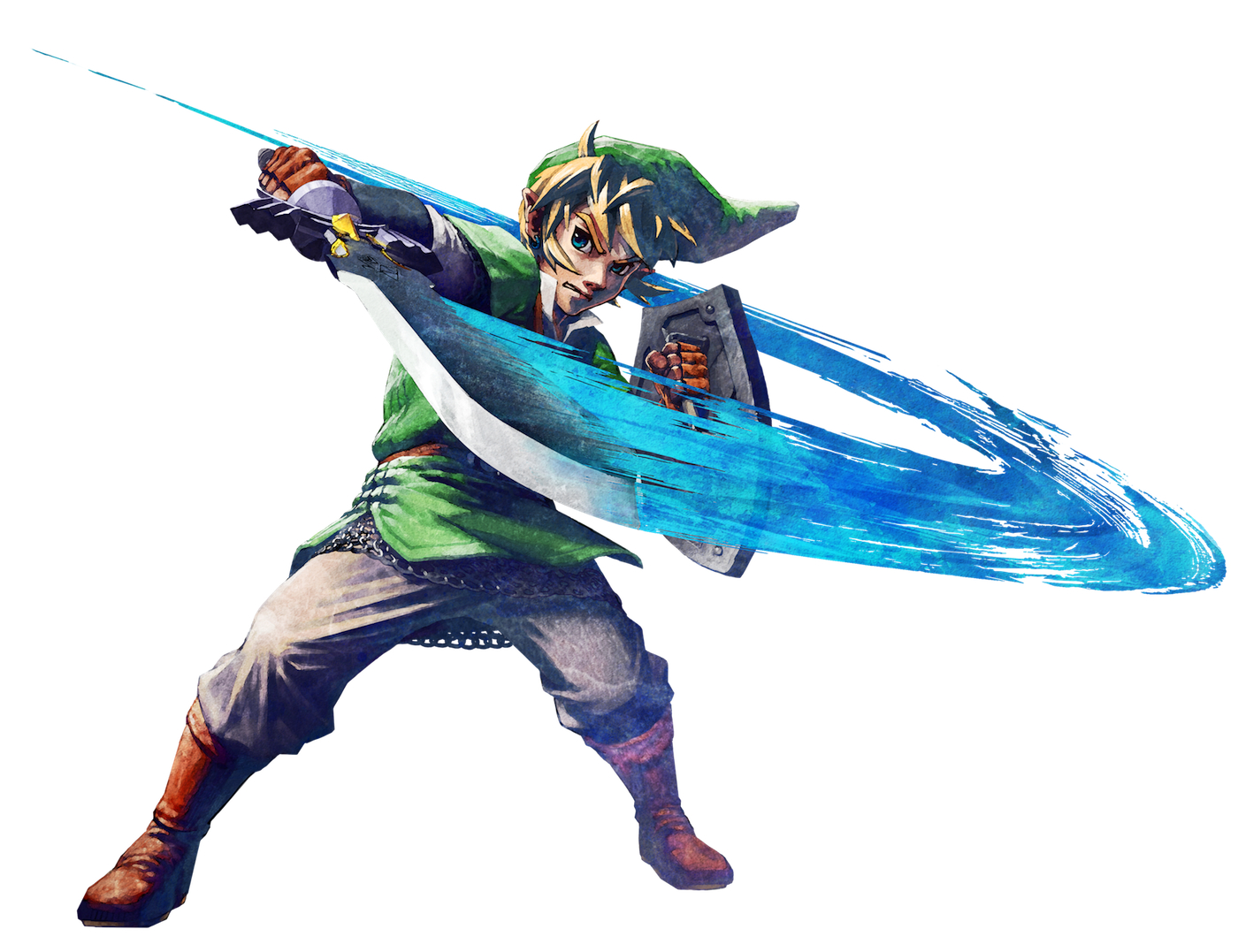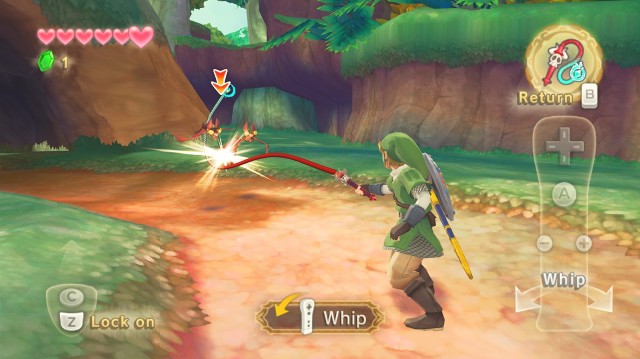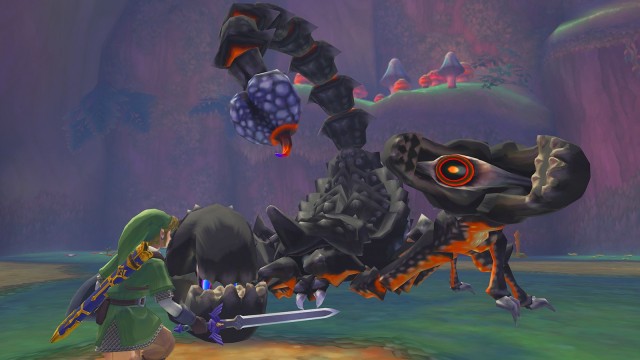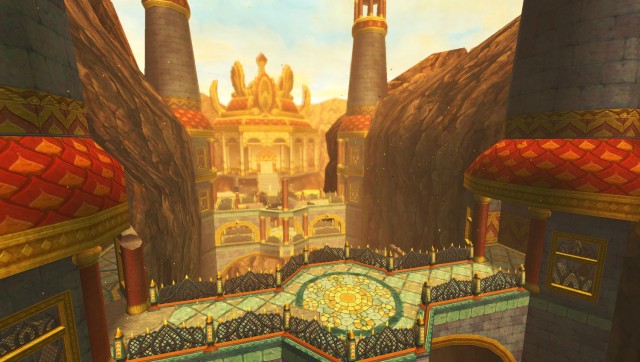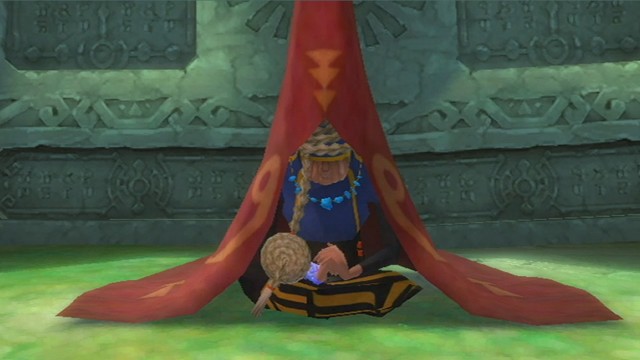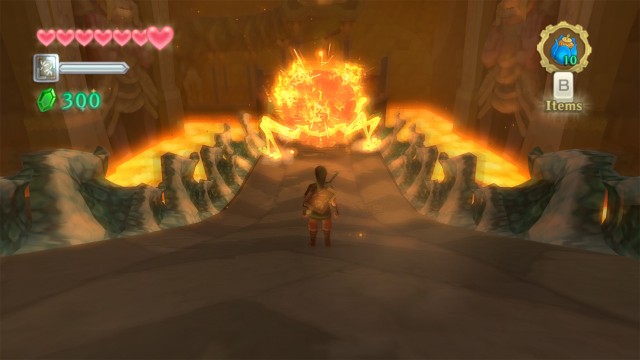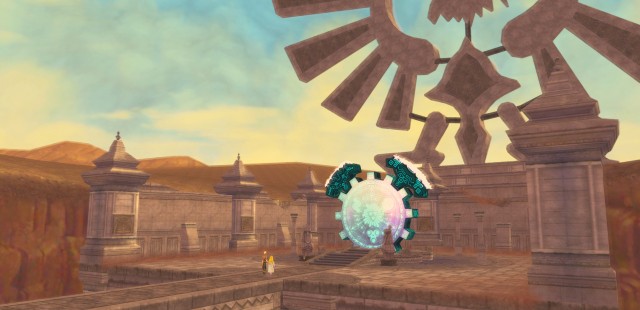I’ve been dreading writing this review. Now, that may sound odd, considering my love for Zelda games, but there is one fundamental reason I’ve been dreading it so: because the likelihood of being disappointed when you’ve hyped a game up in your head so long is quite high. I will say, however, that I’m relieved. In much the same way that Super Mario 3D Land is the best game since Super Mario Bros. 3, I am going to make a pretty bold statement right here, right now:
The Legend of Zelda: Skyward Sword is better than Ocarina of Time.
It’s simple, really: when Ocarina of Time came out in the late nineties, I didn’t have nearly as much fun as I did for the first time (nostalgia set aside so we can create a level playing field here) with that as I have been with Skyward Sword. This is Nintendo at its finest, it’s best game on the Wii, and probably the best game since they put out that iconic Zelda experience for the Nintendo64.
So why is Skyward Sword so incredible? Oh, the reasons…..
First off, there’s lineage. The Legend of Zelda: Skyward Sword, is in fact, an origin story. Taking place before Ocarina of Time, even though Link is arguably older (no, Zelda timelines have never matched up), Skyward Sword tells of the creation of the Master Sword, the most iconic item from the series next to the Triforce itself.
The opening sequence is beautiful and rich, in a style of cave drawings and burnt parchment, if you can imagine the type of ancient story the game is beginning to tell. The entire game is actually laid out this way, not with the animation style of these drawings, but rather with great cinematic set pieces that really bring the story to life and make you emote for one of the first times in a Zelda game. Sure, they’re not as realistic as Call of Duty, but this isn’t Call of Duty, it’s Zelda. And it’s awesome.
The game is gleaming with references to past games, but not in a way that feels like you’re doing the same things every time. For example, there is a very similar questing mechanic to the Gold Skulltula hunt from Ocarina of Time, however the way you obtain Gratitude Crystals is not just a hunt and collect style task, but rather a series of different quests to find people, collect items, and gain the gratitude of your fellow villagers. Other references are more traditional: naming characters after others in the series. For example, Headmaster Gaepora is clearly a nod to Kaepora Gaebora, the infinitely wise owl from Ocarina of Time. Incidentally, the headmaster is also Zelda’s father (no, she’s not a princess yet), which makes me wonder whether or not her name is Zelda Gaepora or if this is just another timeline twist that doesn’t have any bearing on anything past or future in the series. Shigeru Miyamoto, legendary genius behind the Zelda series says there are no timeline connections, so I’ll go with that. Another great connection that brought me all the way back to the Game Boy Color days is the addition of the floating mine carts. These things were tons of fun over a decade ago, and seeing them re-imagined in 3D is tons of fun, to say the least.
As this is a game for the Wii, it makes use of Wii MotionPlus controls. While it isn’t the most precise control scheme in the world, it does help the game shine in more ways than the developers probably even realized. Simply having to sit up properly to fight a boss or tougher monster somehow makes you feel like the game means more and you have to get into it. Sure, that’s not why Wii MotionPlus was designed or even why it was implemented, but it does a great thing by making you really try at these moments; you can’t just mash the A button and expect the boss to go down.
These motion controls also made their way to the shield, where it has become more of a tool than it has ever been in the Zelda series. You thrust the nunchuck forward and your shield performs a bash at the right moment to stun your enemy, letting you deliver a blow with your sword. This is the most shield use I’ve seen in any Zelda game since, well, ever, and it makes you feel like you’re using all of your tools to your advantage.
Speaking of this, using all of your tools seems like a mechanic that has been somewhat lost on the previous Zelda games. It used to be that you would fight halfway through a dungeon, get your knew toy, whether it be the lens of truth, slingshot, or even the shield, beat the boss with it somehow, and you’d barely use it for the rest of the game. In Skyward Sword, I can tell you that of the items I’ve collected so far: the dust bellows, slingshot, bombs, beetle, and bug net, I’ve used all of them in every main area of the game, every dungeon, and to collect tons of different items. Just like the shield, you really feel like you’ve got an assortment of things to use to your advantage, and the brilliant level design makes using these things possible just like that.
There is an upgrade system in the game which doesn’t necessarily feel tacked on, but isn’t a requirement of gameplay, either. On the one hand, it feels good to collect items that can help you upgrade your items and potions, but by the same token, it is a fair distance to travel only to find out you’re missing that one item you’ll never find for another seven hours of gameplay, and you probably won’t bother upgrading it. With that said, upgrades to tend to make the game a fair bit easier, but it’s easy to forget the option is there to upgrade.
Skyloft is the town above the clouds in which you live. There are tons of personalities in the town, more than you’ve ever found in a Zelda game, but they all feel like classic Zelda characters somehow. They’re brimming with personality, whether it be exasperation, excitement, or timidness. And they’re all damn cute.
The flying mechanic in the game is new, and necessary, based on the design of the over world. Rather than a field of wheat and grass, you’ve got Skyloft, and a whole bunch of, well, sky around it, and you hop on your loftwing – a massive bird – to travel among the floating islands and to the surface below. The flying mechanic is intuitive, but I’m not convinced it is better than riding Epona. You never really see your loftwing aside from when you’re in flight, so you don’t have a chance to admire it when it’s just sitting there. There was also no real connection to it in the way you had with Epona taking a liking to you in Ocarina of Time, so the emotional connection just isn’t there. It sounds a bit corny, but for a fan like myself, these things matter. The fact that your loftwing doesn’t even have a name makes it a bit harder to connect, still.
The audio in the game is nothing short of incredible. It is almost a contradiction somehow, whereby the game is not the most beautiful thing ever created from a purely graphical perspective, but the audio is recorded with a full symphony orchestra, opting for real music instead of midi tones for everything right down to the sound of a chest opening and a new item being collected. It’s powerful stuff, and it’s music that really takes off when you play your harp and learn a new song. The tempo speeds up and the songs have a great rhythm. They’re not quite as memorable as the tunes in Ocarina of Time, but you’ll be humming them after just a few hours of gameplay. There is also no voice acting in the game, but I think I like it better that way because it doesn’t restrict your mind to hear what Link would sound like if he spoke. It also makes him a bit more of an unlikely hero because he never actually says anything, so it almost makes him shy or timid, but of course, with his sword and skills, that is clearly not the case. Nintendo might also be pigeonholing themselves if they had a voice actor for Link or the other recurring characters, which is probably why they chose to keep voices out of the series and continue the tradition of grunts and random sounds.
At this point, you’ve no doubt noticed that this review is bursting at the seams with comparisons to The Legend of Zelda: Ocarina of Time. That isn’t a result of obsession with that game or anything of the sort, really. However, I use that comparison because it is widely regarded that that game is the best Nintendo game, if not the best of all games ever created, so comparing Skyward Sword to that is a testament to just how much is exceeds that level of excellence.
Evoking emotion is something that you think would have been done more in previous Zelda games, but it really shines in Skyward Sword. From the beginning, it becomes apparent that Link and Zelda are going to be lifelong friends, and their bond is that of a brother and sister. In a typical Zelda game, your interaction with Zelda stops there, and you begin your quest to find her. However, you never quite have that cherished bond because you go six dungeons before you ever see her again. In Skyward Sword, as you go after Zelda, you actually cross paths multiple times between dungeons and this lends to the importance of finally reaching her and saving her. Seeing the character you’re trying to save throughout the game really makes you feel that much more strongly about the quest, and really gets you in the mood for fighting your way through these baddies to the end. If you let it – if you get deep enough – this game will make you feel, make you cry.
Speaking of these baddies, they’ve all got something unique going on about them. Sure, they have plenty of the same looks as those in previous Zelda games, but all new mechanics for how to defeat them. The Deku Baba (enemy plants you’ve undoubtedly seen in almost every Zelda game) require slashes at the correct angles to tear apart their jaw. The beamos are probably my favourite to destroy, as they no longer require bombs, but rather, they tower over you and require slashes horizontally to bring them to your level and then a sharp jab to destroy them. The idea that all the familiar enemies have been rethought to have new ways to kill them shows you just how much love and care has gone into this game. It probably would’ve been easier to create all new characters that have a design all their own with new ways to destroy them. But it wouldn’t have been Zelda. There are still plenty of enemies that you just slash at to defeat, and it balances out precise swordsmanship with a classic Zelda experience. The developers didn’t over think every character, which makes the combat incredibly well balanced.
Balance is something difficult to achieve when you think about just the sheer volume of enemies in these games. With the typical game with an alien race – take Halo, for example – you’ve got an assortment of probably seven or eight different species, about half of those being really unique from one another. In Zelda, you’ve got about twenty that I can count off the top of my head, some with their own variations even beyond that. There’s a ton of content in Skyward Sword, from enemies to gameplay. I’ve put about 22 hours into the game so far, and I’ve barely breached the half-way mark. If this were Ocarina of Time, I’d be on my second run-through by now.
In fact, there is so much game here, that the first two hours feels like a very smooth tutorial. Not in a bad sense that you might think when you hear the word ‘tutorial’, but rather in a clean and simple way. There’s no real way of explaining it other than it never feels like a tutorial in the traditional sense, but rather a way of helping you along the earlier moments of the games. And even if you’ve played many a Zelda game in the past, you’ll need this, because there are so many new concepts, you’ll want to pay attention.
Skyward Sword is a game of reinvention. You’ll be completing quests along the famous Zelda formula of quest-dungeon-quest-dungeon, but in very different ways. For example, the town is brimming with tons of personality, and you can easily waste away four or five hours at the beginning just fetching things and messing with people’s lives in Skyloft and the surrounding islands. But even the standard dungeon fare has now become more unique, rolling around on massive stone eyeballs through lava pits, using your beetle to reach items and switches a hundred feet in the air (no joke), and so much more. The classic Zelda elements are there: fire, water, air, along with a new one: electricity. And that was a shock. Sorry, I couldn’t resist that one.
Dungeon design is also atypical for a Zelda game. The puzzles are unique and sometimes slightly convoluted, but only for a head-scratching period of about ten minutes or so – enough time to look around, enjoy the scenery, but figure out what you’re supposed to do before you drive yourself crazy and throw the Wii Remote at the screen. I’ve never felt as clever as I have when playing this game. Boss design is even a brand new element. Whereby previous games had the boss in a room with a varied design, the environment can now actually play a factor in design. For example, the first real boss you face involves rolling bombs down a hill at him while he climbs back up and launches fireballs at you. It really takes into account everything you can do with Wii MotionPlus and makes the boss fights much more unique and memorable.
Every time I took a break from Skyward Sword, I felt somehow as if the game kept living. I couldn’t wait to discover what had changed when I returned, even though I knew nothing really had. The characters are memorable, there are truly frightening moments, and for once, the gossip stones actually say something without Link having a mask on!
Now, there have got to be some negatives, right? Well, the Zelda series isn’t really keeping up with the visual technology of the 21st century, but I think that is more a function of the hardware it’s running on. With that said, while most of the game looks beautiful with its watercolour art style, some of the game looks just plain dreadful, but that is probably 1% of the game itself, and can be completely overlooked. The technology Nintendo is ahead of, however, is motion gaming. Kinect and Move fail miserably in comparison to the one-to-one motion tracking of Skyward Sword. The series is starting to show some grey hairs, but only a very small handful of games have this lineage and story foundation, and those greatly outweigh the technological limitations. Nintendo has fussed about it before: story and characters are more important than graphics, and you know what? Story and characters are more important than graphics! This doesn’t need to be Modern Warfare 3, it needs to be Zelda. And that’s exactly what it is.
Given that this game is based around Wii MotionPlus, it is unlikely it will ever see the light of day as a portable title in a decade as Ocarina of Time has (and Majora’s Mask probably will) become. While the sword swinging could be modified to a slash of a button, world, dungeon, enemy, and boss design would have to suffer and it just wouldn’t be the same experience. I guess you’ll just have to keep your Wii around for a little while longer!
The Legend of Zelda: Ocarina of Time is a masterpiece. And it just tells you how insanely great Skyward Sword is, as it is just a slight notch above that game. It is well thought out, intuitive, beautiful, and frightening. Temples can be a beautiful contradiction. They’re brighter than in past Zelda games, but are somehow more deadly. None of the characters feel over thought or contrived. And the heart containers look like beautifully stitched red pillows. They’re gorgeous.
Skyward Sword isn’t about going through the motions, but somehow, it maintains the classic Zelda feel we all know and love. It is the most realistic and palpable Zelda game ever created, and deserves the absolute top honour anyone could possibly give it. The Legend of Zelda: Skyward Sword is my pick for the best game on Wii, best game from Nintendo, and now a contender for the best game of all time. Skyward Sword takes off from Skyloft and lands on earth on November 20th. You have to play it, you have to live it, and I promise you, it will take you away.

